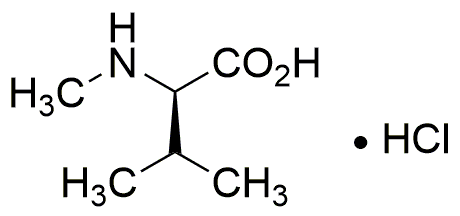N-Methyl-D-valine hydrochloride is widely utilized in research focused on:
- Peptide Synthesis: This compound serves as a building block in the synthesis of peptides, particularly in the development of therapeutic agents that target specific biological pathways.
- Drug Development: It is used in the pharmaceutical industry to create novel drugs, especially in the design of inhibitors that can modulate protein interactions, enhancing drug efficacy.
- Biotechnology: Researchers employ this compound in biotechnological applications, such as the development of enzyme inhibitors that can be used in various industrial processes.
- Neuroscience Research: Its role in studying neurotransmitter systems makes it valuable for investigating neurological disorders, providing insights that could lead to new treatments.
- Structural Biology: The compound is utilized in structural biology to help elucidate the structure-function relationship of proteins, aiding in the understanding of complex biological systems.
General Information
Properties
Safety and Regulations
Applications
N-Methyl-D-valine hydrochloride is widely utilized in research focused on:
- Peptide Synthesis: This compound serves as a building block in the synthesis of peptides, particularly in the development of therapeutic agents that target specific biological pathways.
- Drug Development: It is used in the pharmaceutical industry to create novel drugs, especially in the design of inhibitors that can modulate protein interactions, enhancing drug efficacy.
- Biotechnology: Researchers employ this compound in biotechnological applications, such as the development of enzyme inhibitors that can be used in various industrial processes.
- Neuroscience Research: Its role in studying neurotransmitter systems makes it valuable for investigating neurological disorders, providing insights that could lead to new treatments.
- Structural Biology: The compound is utilized in structural biology to help elucidate the structure-function relationship of proteins, aiding in the understanding of complex biological systems.
Documents
Safety Data Sheets (SDS)
The SDS provides comprehensive safety information on handling, storage, and disposal of the product.
Product Specification (PS)
The PS provides a comprehensive breakdown of the product’s properties, including chemical composition, physical state, purity, and storage requirements. It also details acceptable quality ranges and the product's intended applications.
Certificates of Analysis (COA)
Search for Certificates of Analysis (COA) by entering the products Lot Number. Lot and Batch Numbers can be found on a product’s label following the words ‘Lot’ or ‘Batch’.
*Catalog Number
*Lot Number
Certificates Of Origin (COO)
This COO confirms the country where the product was manufactured, and also details the materials and components used in it and whether it is derived from natural, synthetic, or other specific sources. This certificate may be required for customs, trade, and regulatory compliance.
*Catalog Number
*Lot Number
Safety Data Sheets (SDS)
The SDS provides comprehensive safety information on handling, storage, and disposal of the product.
DownloadProduct Specification (PS)
The PS provides a comprehensive breakdown of the product’s properties, including chemical composition, physical state, purity, and storage requirements. It also details acceptable quality ranges and the product's intended applications.
DownloadCertificates of Analysis (COA)
Search for Certificates of Analysis (COA) by entering the products Lot Number. Lot and Batch Numbers can be found on a product’s label following the words ‘Lot’ or ‘Batch’.
*Catalog Number
*Lot Number
Certificates Of Origin (COO)
This COO confirms the country where the product was manufactured, and also details the materials and components used in it and whether it is derived from natural, synthetic, or other specific sources. This certificate may be required for customs, trade, and regulatory compliance.


